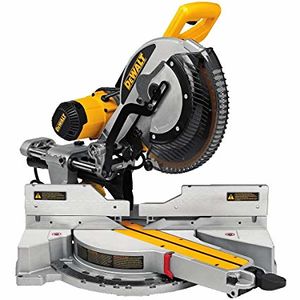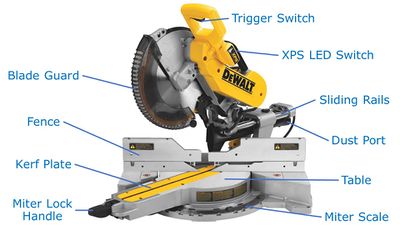Compound Miter Saw
Make: Dewalt
Model: DWS780
Serial Number: 440496
Location: Wood Shop
Ace: Needed (Makerhub@georgefox.edu).
Safety First
- Wear safety glasses.
- Wear hearing protection when operating loud machinery.
- Always know where your fingers are in relation to the blade and never place your fingers under the blade. Keep your guiding hand a safe distance from the cutting area (at least 4”); miter saws have claimed many fingers. There is no SawStop mechanism on this saw, so the blade will continue spinning if it comes in contact with a body part. Never cross your arms while using the miter saw.
- Do not use the miter saw if the blade guard is missing or improperly attached.
- Ensure your workpiece is seated firmly against the fence before making a cut.
- Ensure the workspace and floorspace are clear of clutter and trip/slip hazards. Sawdust can be slippery.
General Wood Shop Attire
- Do not wear any loose fitting clothing. Remove or roll up long sleeve clothing.
- Do not wear any jewelry or accessories such as necklaces, scarves, watches, bracelets, rings, tiaras, or dangling earrings.
- Do not wear open-toed shoes or heels.
- Tie your hair up if it is longer than collar length.
- Do not wear gloves; gloves hinder the ability to effectively use your hands.
All of these items have been known to get caught in moving machinery and/or increase the chances of an accident. Please use common sense and remember that most accidents are completely preventable by paying attention to detail and adhering to safety/training guidelines.
General Notes On Proper Workpiece Size
Many accidents occur simply because a person attempts to cut a piece of wood that is too small or too big. Small workpieces are easily grabbed by spinning blades, and the hand holding the workpiece can quickly follow. Use the 12/3 rule. If your workpiece is smaller than 12” long and 3” wide, seek help from an instructor before making your cut. On the other hand, oversized lumber is under control of the blade, not your hands. Because oversized lumber must be forced into the blade, the extra force required can cause slipping, thrusting, or sudden movements in the workpiece--sending body parts lunging forward toward the blade.
Description
Miter saws are a type of chop saw where the angle of the blade in relation to the fence is adjustable for making angled cuts (a.k.a. miter cuts). Compound miter saws can also tilt the blade to make bevels. They are primarily used for crosscuts through wood and are good for making repeated cuts at the same length.
Here are some example videos of miter saw use.
Terminology/Anatomy
Miter
noun
- A tall headdress worn by bishops and senior abbots as a symbol of office, tapering to a point at front and back with a deep cleft between.
- A joint made between two pieces of wood or other material at an angle of 90°, such that the line of junction bisects this angle.
Other Names: Chop Saw
Workpiece – an object (in this case a piece of wood) being worked on with a tool or machine.
Keeper Piece – the piece you keep; “blessed are the peacemakers, for they shall be called sons of God.” – Matthew 5:9
Offcut – scrap, the waste resulting from cutting a piece of wood.
Fence – a fixture attached to the machine/tool that guides the workpiece in a straight line against it.
Bevel – to cut an inclined or sloping angle (in reference to the z-axis) on a workpiece that is other than 90°; also, the angle itself.
Crosscut – a cut perpendicular to the grain of the wood.
Rip – a cut parallel to the grain of the wood.
Kerf – the wood removed by a saw between the piece you keep and the offcut which is approximately equal to the width of the saw blade.
Stop Block – a block of wood temporarily fixed in place to limit the travel of a workpiece as it is cut; also a block of wood that serves as a reference point when a number of pieces need to be crosscut to the same length.
Sacrificial Fence (Auxiliary Fence) – a temporary fence attached to the main fence that is often damaged during the cutting process, then discarded.
Detent (Positive Stop) – a preset adjustment on a device where the range of motion catches and stops until it is released, usually set for common angles such as 45° or 90°.
Training
Operation
In contrast to the operation of a table saw or band saw, the workpiece on a miter saw remains stationary while the blade moves through it. The blade spins away from the user at the point of contact with the wood; this is why the user should always ensure that the workpiece is firmly against the fence before making a cut. This machine is only intended for cutting wood or wood-like materials. Do not cut metal or any type of ferrous material. All workpieces should be carefully inspected for foreign objects or defects before cutting (including nails, screws, staples, etc.). Do not make rip cuts with the miter saw; the blade is specifically designed for crosscuts. Sliding miter saws can cut wider workpieces than non-sliding miter saws. The maximum 90° crosscut capacity for this saw is 2”x14”. Push the saw through the workpiece (away from you) when using the slide functionality; do not pull the saw through the workpiece (towards you). Cutting on the pull stroke is likely to cause the saw blade to climb on top of the workpiece and violently throw the blade assembly towards the user.
Notes On Proper Measuring
Mark the workpiece at the desired cut-length and use a square to draw a perpendicular line where you want to make the cut. Do not center the blade on the perpendicular line to make the cut because the kerf will cause the keeper piece to be too short (by half the width of the blade). Think about which side of the workpiece will be the offcut and position the blade over the offcut region of your workpiece with the very edge of the blade on the perpendicular line.
Making Cuts
Only cut one workpiece at a time.
Rehearse your cuts before making them. This simply refers to performing the motions of the cut without spinning up the blade to ensure your fingers are clear from the cutting area and to double-check measurements.
When making a cut, squeeze the power trigger while the saw is in its fully-raised position and let the saw reach full speed before cutting into the workpiece. Slowly guide the blade through the workpiece; there is no need for fast movements or excessive downward force.
After the workpiece is fully cut, let the blade come to a stop in the down position. If you lift the saw while the blade is still spinning, the teeth can potentially catch on the wood and throw the offcut in a random direction. This is especially important when using a stop block because the offcut is trapped between the blade and the stop block. In addition, you will get cleaner cuts if you let the blade come to a stop in the down position. You will also get more accurate cuts with the workpiece face up/down instead of on its edge.
Demonstration
For the demonstration, find a piece of scrap wood and make an equilateral triangle.
Certification
Complete the Wood Shop - Compound Miter Saw Module at the link below to gain access to the Compound Miter Saw. The Maker Hub Canvas course pertains to all facilities and equipment contained in the Maker Hub; simply complete the quizzes for the facilities/equipment you wish to use in the Maker Hub. Please email makerhub@georgefox.edu if you have any questions.
Troubleshooting
Maintenance
General maintenance
Insert text
Specific Maintenance Tasks
| Maintenance Procedure | Frequency | Done By |
|---|---|---|
| Sample | Sample | Sample |



